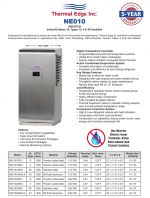Davebones
Senior Member
- Location
- North Of Tampa Fl
New control cabinet roughly 6ft x 6ft x 2ft deep is getting hot inside . We want to add a cooling system to the cabinet due to the heat , humidity in the area , and electronics inside the cabinet . We have a concern about just getting any type of cooling system as this is in a anodizing area with all kind of different tanks . We have ventilation in the room but this doesn't exhaust 100% of the fumes . Can anyone recommend cooling system that would not pull in fumes from outside the cabinet to cool the inside ?



